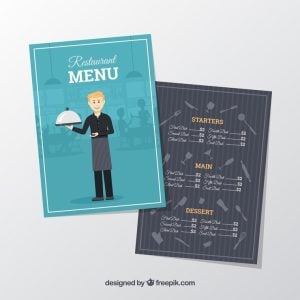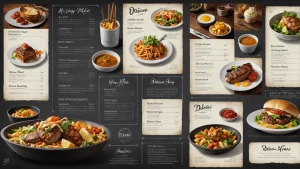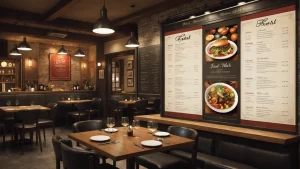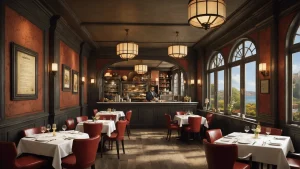Creating a restaurant menu that excites your customers and boosts your bottom line can be a daunting task.
But it doesn’t have to be.
With the right strategies and techniques, you can create a restaurant menu that not only showcases your culinary creations but also drives profitability and customer satisfaction.
In this free, step-by-step guide, we’ll walk you through the process of crafting the perfect restaurant menu, from identifying your target market to optimizing your menu template, layout, and pricing.
Get ready to elevate your menu game and watch your restaurant thrive.

27% higher customer satisfaction
Professional delivery features:
- Real-time GPS tracking
- Automated ETA updates
- Delivery confirmation photos
- 27% higher delivery satisfaction
How to Create Restaurant Menu That Appeals to Your Target Customers
Identify Your Target Market and Their Preferences
To create a menu that resonates with your target customers, it’s essential to understand their demographics, psychographics, and dining habits. Conduct thorough research to gain insights into their preferences, including the types of cuisines they enjoy, their average spending power, and the dining experiences they seek. Interested in enhancing your restaurant’s appeal? Discover these 10 innovative menu suggestions that will entice a steady stream of patrons eager to dine at your establishment.
Analyze your competitors’ menus to identify gaps or opportunities in the market. Look for areas where you can differentiate your offerings and provide unique value to your target customers. Consider factors such as price range, ingredient quality, and dietary preferences (e.g., vegetarian, gluten-free, or low-carb options).
Innovative Menus:
79% of millennials love experimenting with cuisines from different cultures and countries and are more likely to visit a restaurant with varied and innovative food menus.
Curate a Selection of Dishes That Reflect Your Restaurant’s Concept and Vision
With a clear understanding of your brand and target market’s preferences, curate a menu template that aligns with your restaurant’s concept and vision. Create a balanced mix of appetizers, entrees, desserts, and beverages that showcase your restaurant menu’s unique selling points and culinary expertise. Uncover the top restaurant menu designs and secure complimentary tools to craft an eye-catching menu that reflects your eatery’s unique flair.
Develop signature dishes that set your restaurant apart from competitors and leave a lasting impression on your customers. These dishes should embody the essence of your restaurant’s concept and be executed consistently to maintain quality and reputation.
Average Customer Menu Scanning Time:
Customers spend an average of 109 seconds scanning menus.
Balancing Menu Variety and Complexity
When curating your menu, consider the following factors:
-
Variety: Offer a range of dishes that cater to different tastes, dietary requirements, and price points. Include a mix of classic favorites and innovative creations to customize perfect menu and appeal to a wider audience.
-
Feasibility: Ensure that the menu items you include can be prepared consistently and efficiently in your kitchen. Consider factors such as ingredient availability, staff skills, and kitchen equipment when selecting dishes.
-
Seasonality: Incorporate seasonal ingredients and flavors to your menu regularly keep your menu fresh and exciting. This approach not only ensures the use of high-quality, peak-season ingredients but also allows for menu rotations that generate interest among repeat customers.
Optimize Your Menu Layout and Design for Maximum Impact and Profitability
A well-designed restaurant menu is essential for attracting new customers and keeping existing ones coming back. With the right menu design, you can effectively showcase your restaurant’s personality and entice diners to explore your menu offerings. By using professionally designed menu templates, and free restaurant menu templates, maker and tools available online, you can easily design custom menus that reflect your brand and cuisine.
The Power of Strategic Menu Design:
Optimizing menu placement and pricing can lead to a sales increase of up to 25%, according to the National Restaurant Association.
When creating a menu, consider using color combinations, fonts, icons, design elements, layouts and white space to make it visually appealing. You can start creating your menu by simply dragging and dropping images, fonts, icons, and your own logos onto a blank canvas. Utilizing QR codes and a download button in the upper right corner of your menu can make it convenient for customers to access your menu online.
It’s important to feature your menu items, including seasonal dishes, in a way that makes sense for your restaurant. You can customize images to the standard print menu size or create various layouts with separate menus for certain dishes to ensure a good menu flow. Incorporating vivid descriptions and high-quality photos of your dishes can help attract customers and influence their ordering decisions.
Describe Your Dishes, Boost Your Business:
Using descriptive labels on menu items can boost sales by up to 27%, according to Cornell University research.
By offering free online menu maker, with free menu maker templates and a variety of customization options, online menu makers enable restaurants to create great menus that cater to their target market. Whether you’re a small business or a large restaurant, having a well-designed menu that attracts customers is crucial for driving profitability and providing a memorable dining experience.

Metrobi is transforming catering deliveries
Specialized solutions for catering businesses:
- Catering-trained drivers
- Proper handling equipment
- Peak day delivery support
- 23% average cost reduction
Pricing Strategies to Maximize Profitability and Perceived Value
Calculate the Food Cost and Desired Profit Margin for Each Menu Item
Calculating the food cost and setting the right profit margin for each menu item is crucial for the financial success of your restaurant. Food costs should be between 28-35% of the menu price, depending on the type custom size of restaurant. This means that if a dish costs $10 to prepare, its menu price should be around $28-$35 to ensure a healthy profit margin.
To determine the cost of ingredients, labor, and overhead for each dish, break down the recipe into individual components and calculate the cost of each ingredient. Don’t forget to factor in the cost of labor and overhead expenses such as rent, utilities, and equipment maintenance. As chef and restaurateur Tom Colicchio advises, “Know your numbers. If you don’t know your food cost, labor cost, and overhead, you’re flying blind”.
2024 Pricing Expectations:
Most operators raised their menu prices in 2023, but fewer expect to do so in 2024.
Balancing High-Profit and Low-Profit Items
Once you have calculated the food cost and desired profit margin for each menu item, consider offering a mix of high-profit and low-profit items to balance profitability and perceived value. This strategy allows you to attract customers with affordable options while still maintaining a healthy overall profit margin.
As restaurant consultant Aaron Allen explains, “Having a balance of high and low food cost items is crucial for restaurant success. You want to have some items that are really profitable and some that drive traffic and create perceived value for the customer”.
Menu Pricing and Value:
Only 48% of people cited price value as their top 3 factors influencing the place to dine.
Utilize Psychological Pricing Techniques to Influence Customer Perception and Ordering Behavior
Psychological pricing techniques can be powerful tools in influencing customer perception and ordering behavior. One common technique is charm pricing, which involves setting prices just below a round number (e.g., $9.99 instead of $10).This makes the price appear more attractive to customers, as explained by menu engineer Gregg Rapp: “Prices ending in 9, 99, or 95 communicate value to the customer. They feel like they’re getting a deal, even if the actual difference in price is minimal”.
Another effective psychological pricing technique is to avoid using dollar signs or decimals on your menu. This minimizes the emphasis on cost and can lead to higher sales. A Cornell University study found that “guests given the numeral-only menu spent significantly more than those who received a menu with prices showing a dollar sign or those whose menus had prices written out in words”.
Anchoring Techniques
Anchoring is another powerful psychological pricing technique that involves placing high-priced items next to moderately-priced ones. This makes the moderately-priced items seem more affordable by comparison, encouraging customers to choose them over lower-priced options.
As menu psychology expert Dr. Brian Wansink suggests, “Put your most profitable items in the upper right corner of your menu. This is where customers’ eyes naturally go first, and they are more likely to order these items”.
By implementing these psychological pricing techniques and strategically calculating food costs and profit margins, you can create a menu that not only maximizes profitability but also provides perceived value to your customers. This approach will help ensure the long-term success and financial stability of your restaurant.
Best Practices for Launching and Promoting Your New Restaurant Menu
Train Your Staff to Effectively Promote and Upsell the New Menu Items
Your restaurant staff plays a crucial role in the success of your new menu launch. It’s essential to provide thorough training to ensure they can confidently promote and upsell the updated offerings. Start by educating your servers about the ingredients, preparation methods, and unique selling points of each new dish. This knowledge will enable them to answer customer questions and provide enticing descriptions that pique interest.
Encourage your staff to make personalized recommendations based on customer preferences. For example, if a diner expresses a love for spicy food, your server can suggest a new menu item that features bold, fiery flavors. This tailored approach not only enhances the dining experience but also increases the likelihood of customers trying the cuisine and enjoying the new offerings.
Leverage Digital Marketing Channels to Generate Buzz and Attract Customers
In today’s digital age, it’s crucial to harness the power of online platforms to promote your new restaurant menu. Start by sharing enticing photos and descriptions of your new menu items on your social media accounts, such as Facebook, Instagram, and Twitter. Use high-quality images for photos that showcase the dishes in an appealing manner, and craft compelling captions for photos that highlight the unique ingredients, flavors, and preparation techniques.
Online Menu Checking:
Nearly 85% of diners check the restaurant menu online before visiting the restaurant.
To incentivize customers to try your new menu, consider offering exclusive promotions or discounts to your social media followers. For instance, you could provide customers order a complimentary appetizer or dessert with the purchase of a new entree. This tactic not only encourages customers to visit your restaurant but also creates a sense of excitement and urgency around your updated menu maker and offerings.
Another effective digital marketing strategy is to partner with local food bloggers or influencers to showcase your new menu. Invite them to your restaurant for a complimentary tasting, and encourage them to share their experiences with their followers. This collaboration can expose your brand and restaurant to a wider audience and generate positive word-of-mouth buzz about your updated menu.
Host Special Events or Tastings to Showcase Your Updated Menu Offerings
To create a memorable experience around your new menu launch, consider hosting special events or tastings that allow customers to sample the updated offerings. This could include free menu, a themed dinner event, a prix-fixe menu featuring new dishes, or a “meet the chef” night where diners can learn about the inspiration behind the updated menu.
Menu Updates:
31% of restaurateurs update their menu on a monthly basis, while 24% do it seasonally.
During these events, encourage your staff to engage with customers and provide detailed information about the new dishes. This personal touch can help build relationships with your patrons and create a sense of investment in your restaurant’s success.
By implementing these best practices for launching and promoting your new restaurant menu, you can generate excitement, attract new and existing customers together, and ultimately drive sales. Remember, the key to success lies in properly training your staff, leveraging digital marketing channels, and creating memorable experiences that showcase your updated offerings.
The Psychology of Menu Design
Menu design goes beyond aesthetics; it involves understanding the psychological factors that influence customer behavior. For example, studies have shown that customers tend to remember the first and last items on a menu more easily, a phenomenon known as the “primacy and recency effect”. Restaurants can leverage this by placing high-profit items or signature dishes in these strategic positions.
Another psychological tactic is the use of “decoy” items. By including a high-priced item on the menu, restaurants can make other items appear more reasonably priced in comparison, encouraging customers to choose the relatively cheaper options.
The Impact of Menu Engineering on Restaurant Profitability and Success
Menu engineering is the strategic process of designing and pricing menu items to maximize profitability. By analyzing sales data, customer preferences, and ingredient costs, restaurants can make informed decisions about their menu offerings and pricing structure.
The goal of menu engineering is to have restaurant menu maker strike a balance between customer satisfaction and restaurant profitability. This involves:
Identifying high-profit, high-popularity items (known as “stars”) and promoting them strategically
Minimizing or eliminating low-profit, low-popularity items (known as “dogs”)
Adjusting prices based on ingredient costs and customer perceived value
Continuously monitoring sales data and making data-driven decisions
By optimizing their menu mix and pricing strategy, restaurants can boost their average check size, improve profit margins, and foster customer loyalty.
Profit Boost with Smart Engineering:
Effective menu engineering can increase a restaurant's profitability by up to 15%.
Common Challenges and Pitfalls to Avoid To Create a Restaurant Menu
Creating a restaurant menu is not without its challenges. Even experienced restaurateurs can fall into common traps that can negatively impact their business. Let’s explore some of these pitfalls and how to avoid them.
Menu Pricing and Profit:
Just by accurately managing the inventory, a restaurant could record up to a 24% increase in profit margin.
Overcomplicating the Menu with Too Many Options or Confusing Descriptions
One of the most common mistakes restaurants make is trying to offer too many options. While variety is important, an overly extensive menu can be counterproductive. As renowned chef and restaurateur Gordon Ramsay points out, “A menu with too many dishes is a sign of confusion. It’s better to do a few things well than to do a hundred things poorly.”
Menu Reduction:
Nearly 24% of restaurant owners have reduced the number of items on the menu in 2023
A cluttered menu can overwhelm customers, making it harder for them to make a decision. This can slow down the ordering process and create bottlenecks in the kitchen. Furthermore, confusing or overly technical descriptions can alienate customers and detract from the appeal of the dishes.
Neglecting to Regularly Review and Update the Menu Based on Sales Data and Customer Feedback
A restaurant menu should not be a static document. Customer preferences change over time, and a stagnant menu can lead to boredom and decreased repeat business. Additionally, failing to remove underperforming items or adjust prices based on sales data can hurt your profitability. For restaurants looking to maximize the appeal of their menu offerings, considering a fixed-price approach may be beneficial. A well-implemented prix fixe menu can simplify diners’ choices while also maximizing revenue potential. To learn more about crafting an effective prix fixe menu and leveraging its benefits, check out this insightful guide on designing a prix fixe menu.
Restaurant Review Impact:
77% of consumers will visit a restaurant’s website before dining there or ordering food online.
To keep your menu fresh and optimized, regularly solicit customer feedback and analyze sales metrics. This data can help you identify opportunities for menu updates, such as removing unpopular items, adjusting prices, or introducing new dishes that align with customer preferences. For those looking to enhance their menu design, explore these top restaurant menu template options that come with free resources to elevate your dining experience.
By avoiding these common pitfalls and continuously refining your menu based on data and feedback, you can create a menu that delights customers, streamlines operations, and drives profitability for your restaurant.
Crafting Your Perfect Menu
Creating a restaurant menu that appeals to your target customers and maximizes profitability is a multi-step process. By identifying your target market, curating a selection of dishes that reflect your restaurant’s concept, and optimizing your menu layout and design, you can create a menu that stands out from the competition. Unlock the secrets to designing a menu for a restaurant that captivates guests and drives revenue.
Strategic pricing and menu engineering techniques can help you maximize profitability while maintaining perceived value for your customers. Effective staff training and digital marketing efforts can generate buzz and attract customers to your new menu offerings.
A well-designed menu is a powerful tool for shaping the customer experience and driving your restaurant’s success. By avoiding common pitfalls and regularly reviewing and updating your menu based on sales data and customer feedback, you can ensure that your menu remains a key driver of your restaurant’s growth and profitability.
Are you ready to take your restaurant to the next level with a perfectly crafted menu? Start by analyzing your target market and assessing your current menu offerings. Identify opportunities for improvement and implement the strategies outlined in this guide to create a menu that truly sets your restaurant apart.





























